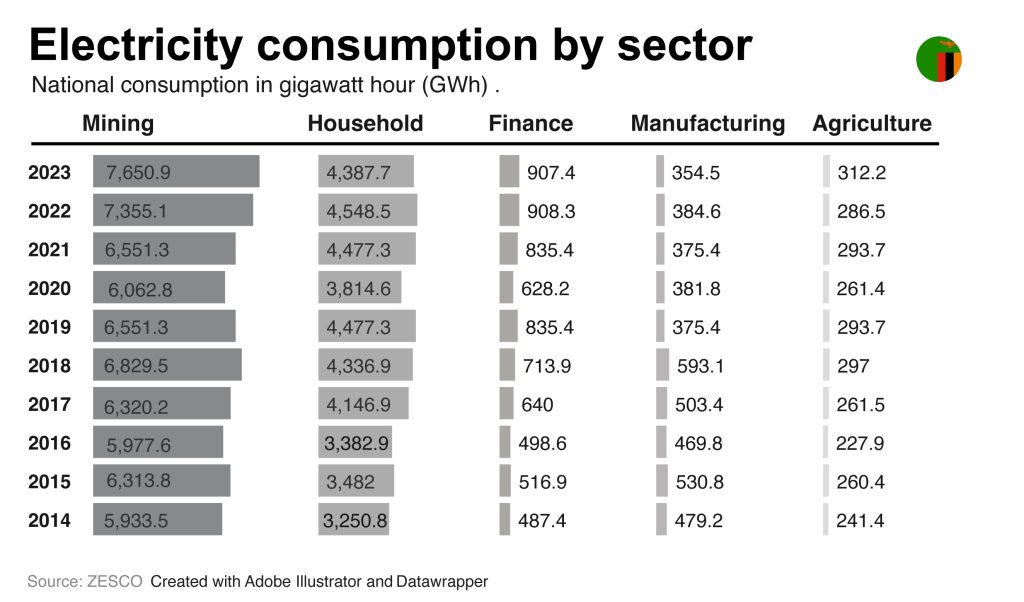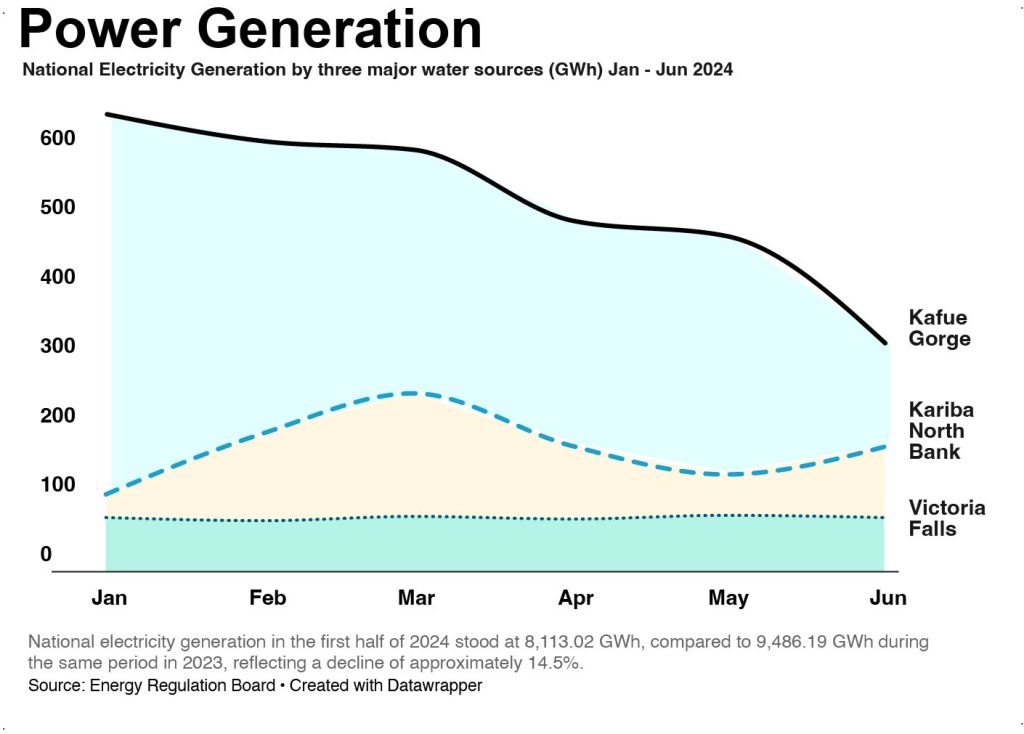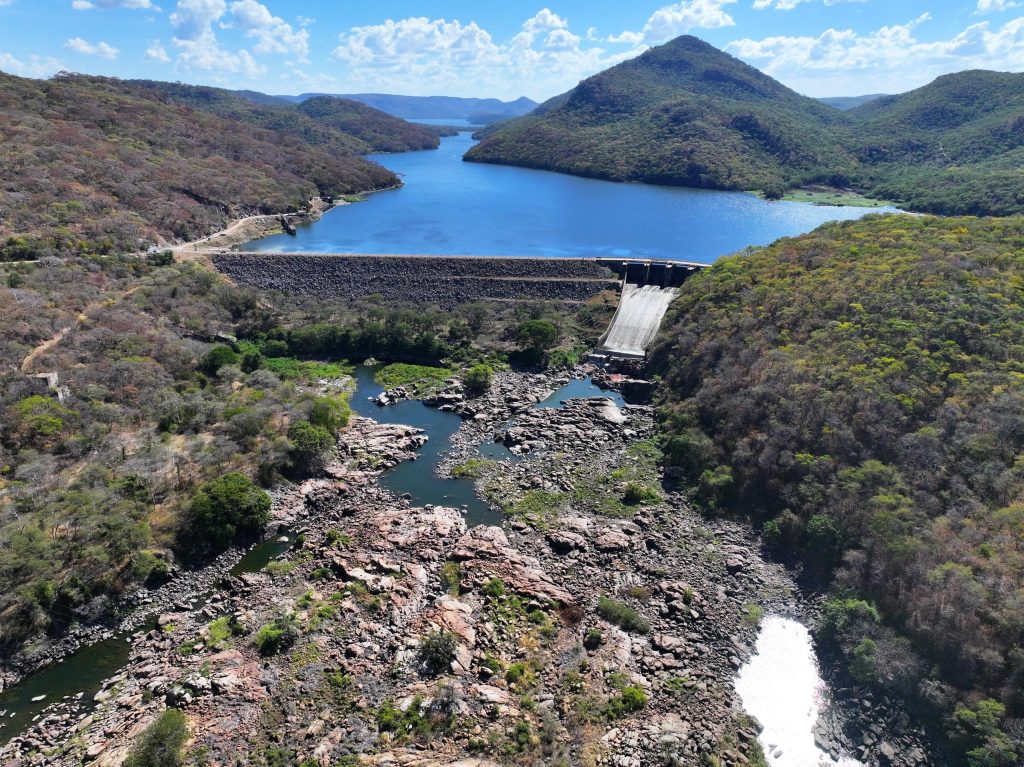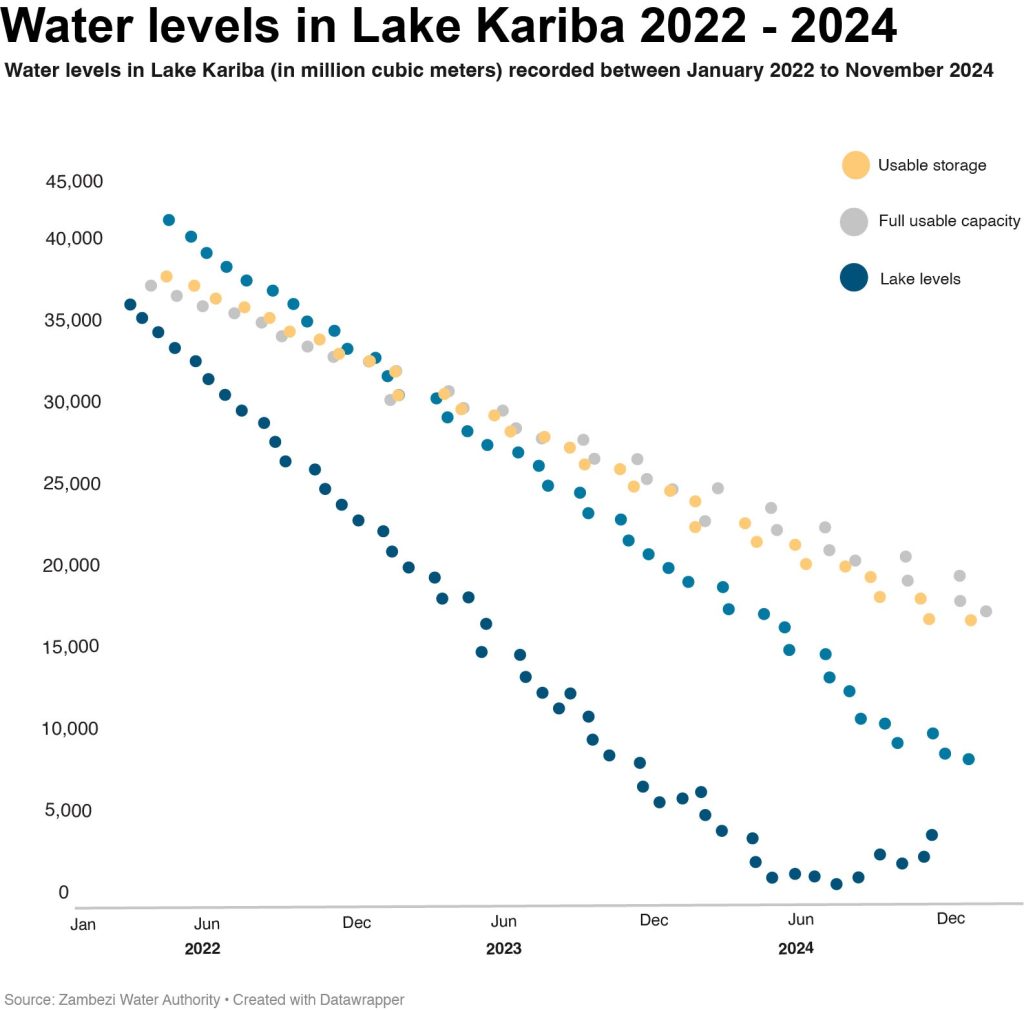THE TIMES OF ZAMBIA investigation into how Global Warming throttles power transition in Zambia was made possible with the support of the Pulitzer Centre
By Cindy Sipula
AS Zambia grapples with severe electricity shortages and the looming threat of El Niño, citizens confront the harsh realities of life without power. The cascading effects of this energy crisis on daily life, small businesses, and the nation’s development highlight the urgent need for solutions in a country where access to electricity remains a pressing challenge.
With nearly half Zambians with access to electricity, according to the World Bank’s 2022 development indicators, the lack of power for over 20 hours per day has frustrated many whose businesses depend on it.
Zambia’s electricity is mainly consumed by the mining sector which ingests approximately over 7000 GWh annually with the agriculture sector consuming the least electricity as evidenced by the 2023 consumption rate of 312.2GWh.
While the mining sector leads in power consumption, electricity consumption in other sectors like households and agriculture remains steadily low.

Even more so, the return of El Niño has heightened existing vulnerabilities, affecting food security, water resources, and power generation, in Southern African countries that depend on hydropower generation.
The 2023–2024 El Niño has been classified as the fifth most powerful El Niño–Southern Oscillation event in recorded history, bringing widespread droughts, flooding, and other natural disasters across the globe.
Still grappling with the lingering impacts of the COVID-19 pandemic and various economic challenges, Zambia has not been spared from El Niño’s adverse effects, which are now impacting the nation’s economic and social outlook.
At the break of dawn, as the sky rests in muted shades of blue over a peri-urban area of Lusaka, Victoria Mwaba wakes to the profound quiet that has followed more than 48 hours without electricity. The once-familiar hum of the fridge is long forgotten.
She stretches slowly, already weary of the day’s challenges. Life without power has been hard for her and her family of seven. Water taps have run dry, and the only dependable water pump in the compound remains idle. Forced to gather water by hand from the nearest borehole, she joins many others who rise before sunrise to meet the day’s needs the old way.
“We have not had water for the last four days, even when we have electricity now. We can’t access water because Lusaka Water had already stopped supplying water at the time power was restored,” Mwaba muttered.
Victoria Mwaba’s struggles with energy access as a resident of Kabanana Compound symbolise one of the many difficulties facing Zambians, reflecting a broader issue across the country.
Peter Muleya, a welder from Kalingalinga Compound, who supports his family through his welding business, describes the ongoing electricity shortages as a setback to the country’s development, particularly impacting the common man and small businesses like his.
“This is not the first time our country is facing an energy crisis, and we should have had a more prepared approach to such situations, the first time it hit us in 2015,” Muleya echoed.
He laments on how he has had to adjust to a new sleeping pattern so as he can work anytime electricity is restored adding that most of the time it is restored after midnight. This then forces him to work at odd hours, causing a risky life prone to likely attacks by thieves.
The decline in rainfall has significantly lowered water levels in the Zambezi and Kafue River basins, posing a serious threat to the country’s power generation capacity and leaving many households in total darkness.
For decades, Zambia’s electricity production has relied heavily on hydropower, which accounts for 83% of the country’s electricity supply. Coal contributes 9%, solar 3%, and heavy fuel oil 5%.
Zambia Electricity Supply Corporation (ZESCO), the state utility responsible for most of the nation’s electricity, acknowledges the severe impact of load shedding on businesses. ZESCO attributes the surge in load-shedding hours—from eight to 21 hours per day within seven months—to reduced power generation at its three primary hydro plants: Kafue Gorge Lower, Victoria Falls, and Kariba North Bank Power Station.
Statistics for hydroelectric power generation in the three dams over a 10 -year period shows that Kafue Gorge peaked significantly in 2023 when power generation was at its optimal capacity at 7497GWh.
The recent drought has affected the power generation in the three dams indicating a significant decline in electricity production. However, this is not the first drought experienced by Zambia as the Kariba North Bank and the Kafue Gorge Lower Power plants experienced a relative decline in power generation between 2015/2016 rain season.

Kariba North Bank Power Station shuts down five turbines
The Kariba Dam, Zambia’s largest water reservoir, is situated in the Zambezi River basin shared with Zimbabwe and forms Lake Kariba, which stretches about 280 kilometers in length in Siavonga District, Southern Zambia.
Each year, Lake Kariba receives an average of 46 billion cubic meters of water from the Zambezi River. This water is divided between the Kariba North Bank Power Station in Zambia and the Kariba South Bank Power Station in Zimbabwe for electricity generation
Olipa Mudenda, a native of Siavonga District, has been in the fish business for over 13 years. Since early April, however, her business has struggled as customers have dwindled, and much of her fish goes to waste.
“Sometimes I do not understand when my customers from Lusaka tell me they cannot buy too much fish because it will go to waste due to load shedding,” she said.
Pointing toward Lake Kariba, she questioned why Zambia is still facing severe blackouts when the lake contains water.
“We have so much water here in the lake, I don’t understand what they mean, the lake is drying up,” she whispered.
Ms. Mudenda is not alone in struggling to grasp the extent of the 2023/24 El Niño surge’s impact on water availability in Lake Kariba.

However, Engineer Christopher Chisense, Director of Water Resources and Environmental Management at the Zambezi River Authority, has revealed that, as of October 21, 2024, Lake Kariba holds only 4.9% of usable water for power generation.
Eng. Chisense noted that 2024 has seen a steep decline in usable water levels compared to 2023, when it was around a fifth at the same time of the year. ‘Currently, water levels are receding, with only a meter of usable water remaining, which has led to constraints in power generation,’ Chisense explained.
“Normally, water levels reach their highest peak around June and July, usually above 5 meters operation level, however the 2023/2024 season did not perform very well resulting in a decline in the water levels,” he added.

Meanwhile, the Kariba North Bank Power Station has closed 5 of its 6 generating units due to decreased lake levels. This shutdown has drastically reduced electricity generation capacity from the initial 1,080 megawatts to only 214 MW.
Kariba North Bank Power Station Chief Engineer Operations, Stanley Singoyi stated that the power station has exhausted its allocated 8 billion cubic meters of water for power generation, prompting the utility company to implement emergency load-shedding schedules.
“We are only running one generating unit at the power station and this has put a strain on the supply of electricity to our customers,” he said.
Continuous pumping of water at the Kariba North Bank Power Station risks an additional 18 months of power outages due to potential air bubbles that could increase vibration and noise within the turbine, threatening its stability and leading to mechanical failures, according to Engineer Singoyi.
Power generation at the Kafue Gorge Lower Hydro and Victoria Hydro Power plants has also drastically declined due to ongoing drought conditions in Zambia.
Peter Mumba, the Permanent Secretary Technical in the Ministry of Energy, stated that reduced power generation has significantly cut power exports to other countries. He noted that the withdrawal of 400 MW from exports has resulted in ZESCO losing approximately $370 million monthly.
The 2024 mid-year Statistical Bulletin from the Energy Regulation Board reveals a drop in electricity exports from 302 539.74 MWh to 259 790.89 MWh between January and June 2024, while electricity imports surged from 70 830.72 MWh to 128 776.81 MWh during the same period.
To mitigate power outages, ZESCO is importing electricity from South Africa, Mozambique, and Zimbabwe, but is not currently selling any power from its generation at the Kariba North Bank Power Station.
Electricity Act No 11 of 2019
This Act regulates the generation, transmission, distribution, and supply of electricity to enhance the security and reliability of electricity supply. It provides for the sale and purchase of electricity both within and outside the country, facilitates the efficient and sustainable development and operation of electricity infrastructure, and defines the roles and responsibilities of various participants in the electricity sector.
Additionally, it aims to attract adequate investment in the sector, establishes a multi-year tariff framework, promotes transparency in risk, cost, and revenue allocation among participants, and ensures the protection and safety of electricity consumers and the public. The Act also repeals and replaces the Electricity Act of 1995 and addresses related matters.
The current power outages in Zambia have a long-term negative impact on the economy, according to energy expert Boniface Zulu. Recognised as one of the youngest experts in the field of engineering, Boniface Zulu, 29, highlights that the rising cost of living is making it difficult for businesses to thrive. He urges the government to expedite the implementation of cost-reflective tariffs to ensure a stable energy supply.
“Zambia has the lowest electricity tariffs in the SADC region and this has continued to affect ZESCO’s operations in times like this when the country is hit with a severe drought,” he said.
The Energy Regulation Board (ERB) recently approved ZESCO’s application for emergency tariffs aimed at raising US$15 million monthly from retail customers. This revenue will contribute to importing 788 MW of power to alleviate the ongoing load shedding.
ZESCO reports a current power deficit of 1,300 MW against its installed capacity of 3,356.6 MW. Manufacturers and energy experts have welcomed this move, noting it will not only mitigate load shedding but also stabilize the country’s economy.
Engineer Boniface Zulu has called for public-private stakeholder engagements to address the impacts of drought on Zambia’s power generation. The increase in tariff charges is viewed as a temporary measure, as ZESCO expects to reduce load shedding hours from twenty-one to seventeen until a stable power supply is anticipated to be in place around February or March 2025.
The Zambian government has identified the load shedding crisis as an opportunity to diversify energy sources, emphasizing the installation of solar and diesel-powered generators.
Peter Mumba, the Technical Permanent Secretary in the Ministry of Energy, announced that the government is developing a 100 MW solar PV power plant in Chisamba, projected to take ten months to complete. Additionally, the ministry, in collaboration with ZESCO, has deployed 23 diesel generators to critical locations such as markets and hospitals across the country.
The government is also promoting rooftop solar installations in public institutions and households, which has led to the adoption of a Net-Metering Policy. In response to the severe effects of load shedding, the Zambian government has implemented measures to enhance consumer support.
Cabinet has approved the removal of import taxes on all solar equipment, and the ERB, in collaboration with the Zambia Revenue Authority, has announced that importers are no longer required to obtain a one-off waiver to import solar equipment for domestic or non-commercial use. This policy change facilitates tax-free imports of solar equipment, allowing more homes to transition to renewable energy sources.
To further promote the integration of variable renewable energy sources, the Energy Regulation Board (ERB) has introduced the Zambian Distribution Grid Code and the National Energy Policy 2019. The Ministry of Energy, with support from the European Union under the Increased Access to Electricity and Renewable Energy Production (IAEREP) project, is developing regulations to detail the implementation of Net-Metering (NEM) in the country.
This mechanism allows electricity consumers—both residential and commercial—who generate renewable energy for their own use to export any excess electricity back to the grid and receive credits for it. These consumers, known as “prosumers,” can potentially earn additional income over time. A predetermined tariff approved by the ERB will apply to the exported electricity and will offset the electricity consumed from the grid by the prosumer.
Signed into law and published in the Government Gazette on July 5, 2024, the Electricity (Net Metering) Regulations enable Distribution Network Service Providers like ZESCO to offer a net metering program to their consumers. The ERB is collaborating with the Zambia Bureau of Standards and the Zambia Compulsory Standards Agency (ZCSA) to develop standards that will ensure the quality of renewable energy products entering the country is closely monitored.
ERB Public Relations Manager Namukolo Kasumpa stated that the board is also working with the Engineering Institution of Zambia (EIZ) to ensure that enterprises trading in renewable energy products are licensed with the ERB and registered with EIZ.
“For those not licensed, the ERB is coordinating with the Zambia Revenue Authority (ZRA) to ensure that those importing solar products for domestic or non-commercial use comply with the self-declaration requirements at border entry points,” Mrs. Kasumpa said.
2024/25 Rainfall Outlook
In February 2024, President Hakainde Hichilema declared the prolonged drought caused by El Niño a National Disaster. However, the 2024/25 rainfall forecast has brought hope to both ZESCO and the Zambezi River Authority. Regional and international weather experts, meeting during the Southern African Climate Forum in Harare, Zimbabwe, in August, projected that the Southern African Development Community (SADC) region would experience normal to above-normal rainfall during the 2024/25 season.
The Zambezi River Authority has allocated 27 billion cubic meters of water for power generation, to be shared equally between ZESCO and the Zimbabwe Power Company, with each receiving 13.8 billion cubic meters.
ZRA Director of Water Resources and Environmental Management, Engineer Christopher Chisense, announced that the authority is considering a water harvesting plan to develop three additional sites, augmenting the existing capacity at Kariba Dam. These new sites include the Batoka Gorge Hydro Electric Scheme, with a capacity of 2,400 MW; the Mupata Gorge Hydro Electric Scheme, with 1,200 MW; and the Devils Gorge, also with a capacity of 1,200 MW.
“It is important to note that environmental impact assessments have already been completed for the Batoka Gorge Hydro-Electric Scheme. ZRA is in the process of establishing additional water storage infrastructure to complement the existing setup at Kariba North Bank, which has a total generation capacity of 4,800 MW,” Eng. Chisense explained.
Reduced water allocations to the two power stations will have nearly equal effects on both ZESCO and the Zimbabwe Power Company.
In the pursuit of sustainable energy, hydropower has long been a cornerstone of renewable electricity generation, harnessing the force of flowing water to produce clean, reliable energy. However, as climate change accelerates, its unpredictable impacts threaten the future of this once-dependable energy source. The relationship between water and energy has become increasingly complex, with shifting rainfall patterns, prolonged droughts, and more frequent extreme weather events reshaping hydropower’s role in the global energy mix.
As Zambia seeks solutions to its energy and water crises, it’s worth noting that the El Niño phenomenon could lead to a La Niña, according to a World Meteorological Organisation press release from September 2024.
Secretary-General Celeste Saulo reported that the past nine years have been the hottest on record, despite the cooling effects of a prolonged La Niña from 2020 to early 2023. The El Niño event for 2023-24 emerged in June 2023, peaked between November 2023 and January 2024, ranking among the five strongest El Niño events recorded before gradually dissipating, although some impacts linger.






